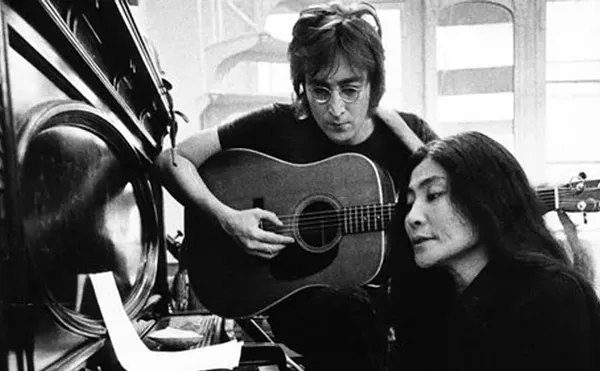
Audio By Carbonatix
[
{
"name": "GPT - Leaderboard - Inline - Content",
"component": "35519556",
"insertPoint": "5th",
"startingPoint": "3",
"requiredCountToDisplay": "3",
"maxInsertions": 100,
"adList": [
{
"adPreset": "LeaderboardInline"
}
]
}
]
The coffee-table book has long been a cliché, a joke and an institution, depending on your point of view (and relative degree of snobbishness). But now, with the publication of these gorgeous, jewellike volumes, you can bring an aura of cultural and aesthetic enlightenment to your coffee table. But be forewarned: As beautiful as they are, these are big books, in both size and concept. Get set for some heavy — though not inaccessible — reading.
Celestial Gallery
by Romio Shrestha and Ian A. Baker
Callaway Editions, $125, 64 pp.
Some visions are easily contained in the mind — a haiku by Basho, for instance. Others — the Palace of Versailles, the Taj Mahal — burst out, needing acres and acres to be realized.
The dimensions of Tibetan master painter Romio Shrestha’s works — from 2 feet to 9 feet high or wide — while not extreme in Western terms, present a few problems for anyone reproducing them in a book. Many of Shrestha’s images from the Tibetan Buddhist tradition are mandalas, incredibly detailed, brilliantly colored and teeming with quintillions of spiritual signs. Which is why Callaway Editions has published a coffee-table book that only needs four legs to become a table itself. At 16-and-a-half inches-by-24 inches, Celestial Gallery gives each of its 35 huge, eye-zapping color plates — representing Buddha Sakyamuni, Avalokiteshvara (the bodhisattva of great compassion), the Wheel of Deluded Existence et al — the benefit of ample room and elegant printing.
As Deepak Chopra says in his foreword, “you will encounter an inner realm previously hidden from sight.”
One Man’s Eye: Photographs from the Alan Siegel Collection
Robert Sobieszek, Alan Siegel, Miles Barth
Harry N. Abrams-Word Wise Press, $49.50, 176 pp.
The Ringling Brothers freaks on the cover of One Man’s Eye seem to promise a collection of weird, scandalous, strange-but-true pictures in this album of one collector’s favorites. Instead we get a beautifully purposeful sequence of 20th century works by photographers both celebrated and unknown, covering the various subgenres of camera art: portraits, still lifes, nudes, landscapes and much more — Imogen Cunningham’s yawning Calla lilies, Man Ray’s abstractions, Irving Penn’s ethnographic studies, Robert Frank’s priceless slices of ’50s America, Rocky Schenck’s ghostly silhouetted trees. Siegel clearly knew what he was looking for in bringing together this excellent cross section. There are enigmatic shots and masterpieces, poignant moments and public emotional displays. One of the best is Garry Winogrand’s Los Angeles, Ca. (1969), in which three lovely young ladies on a street at sundown hesitate before the sight of a young man hunched over in a wheelchair. Of the 120 plates, 30 are in full color, and every one is worthy of a long, thoughtful gaze.
Leafing Through Flowers
by Daniel Ost
Callaway Editions, $95, 236 pp.
Forget having an arrangement of flowers displayed on your coffee table. Instead, install this gorgeous volume of exquisitely photographed, masterfully executed floral designs that will make your local florist’s most exotic bouquets look dowdy.
Not that there’s anything wrong with a bunch of lilies or daffodils, especially in the middle of winter, but these floral art works, created by noted Belgian designer Daniel Ost, go beyond mere home decor and into the realm of conceptual installations. Ost’s work takes floral design into an at once ethereal and earthly space, pushing the boundaries between art and design, arrangement and nature.
Ost’s work is inspired by fine art, and this stunning collection, which includes more than 200 full-color images, presents clearly contemporary pieces that call to mind various eras of art history, from baroque to minimalism and through some fantastic phases in between. In one, the sensuous beauty of a Georgia O’Keeffe, in another the rambunctious abundance of a Rubens. And it’s all done with flowers. For Ost, flowers, plants and leaves, twigs and sticks and other vegetative matter are simply materials to be used for their textural and tonal qualities. The issues of line and form, mass and color are essential to any floral design, but Ost’s work takes these elements more than seriously. By experimenting with the way stems and leaves, petals and twigs can be used independently, grouped or in ikebanalike precision, he has created an oeuvre of floral art that is as sculptural as it is ephemeral.
And the book demonstrates that to the most beautiful advantage. Ost’s work is glorious, glamorous and gorgeous. And it’s bound to turn Martha Stewart, with her precious little posies, celadon green with envy.
Prague 1900: Poetry and Ecstasy
Edwin Becker, Roman Prahl and Petr Wittlich
Reaktion Books, $57, 224 pp.
What do we care about a city in Europe a hundred years ago? Why should we take note of its cultural life, its music, poetry, painting and decorative arts? Well, no reason, really, unless we actually want to know what we’re talking about when we use the word “bohemian.”
Prague in 1900 was undergoing a transformation from being the capital of the ancient nation of Bohemia to being a city on the cutting edge of European culture. Less recognized than the cultural powerhouse of Vienna, it was in its own right a hotbed of artistic expression that would become part of the foundation for many of the 20th century’s great art movements, from art nouveau to German expressionism and more.
Prague 1900, in what might be called the ultimate Bohemian wrap-up, collects 10 essays about the arts and culture of the time, from posters to poetry, from music to painting. Accompanying these are sumptuous illustrations, many reproduced in full color, of the great (and lesser) artworks of the time. And to round it off, a brief biography of each artist is included, so you’ll be able to recognize even more names on your next museum trip.
So even if the great museums of Europe (the French Musée d’Orsay and the Czech Republic’s Gallery of the City of Prague, among dozens of others, loaned pieces to this collection) aren’t on your travel agenda this winter, you can still feel as though you’ve taken a cultural journey. Think of it as the completion of the one Prague’s cultural elite set out upon a century ago.
George Tysh is the Metro Times arts editor. E-mail him at gtysh@metrotimes.com




